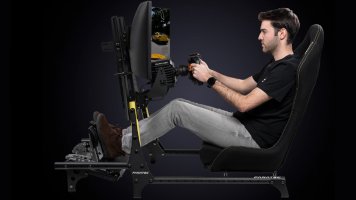I agree with not overloading units. But at the same time, I'd rather someone have one or two units and have very limited effects on them such as engine and maybe a collision effect, than simply thinking that to use tactile I need a million units or I might as well not even bother.
It also avoids the endless loop of buying testing selling re-buying hardware instead of doing the thing which our tactile is for in the first place and that's racing.
I'm not saying to buy one unit, keep it simple and then jam every effect Simhub offers into it.
Here are some questions for you or anyone that wants to respond...
Consider this, perhaps it's not even necessary to jam a pile of effects into a single unit to cause a scenario of diminishing returns from that unit being used?
If you have multiple effects that are active at the same times that the unit has to generate, what happens?
Also, the frequencies set to be used for these effects. What other additional frequencies do these contain and what harmonics may also be generated? Really now, what is the combined generated tones/harmonics that the transducer is needing to generate with the effects selected?
Would it help knowing these factors?
Seriously, what happens with the frequencies these effects use that are shared in each effect when several are being generated at the same time? These frequencies in question that are being used, how then does the transducer used, actually represent them?
So what about the transducer itself being used, surely it has its own character/signature in how it may represent some frequencies clearer or better than others. Ahh, but which are they if so?
A common issue with most transducers that people will use. They create many of their effects within the 30-80Hz range. Simply as these feel best. Out of that range @35Hz-55Hz may have the most punch. So what happens is in effects they use these favored frequencies or similar frequencies for multiple effects?
Yet if a user has hardware that can only properly represent part of the bass range. Then they are missing both low bass potential as well as subharmonics and also naturally created harmonics that the fundamental frequencies used for effects will generate.
My point is, we can make better effects when we begin to understand better these factors, when we see what happens with frequencies and their
amplitude when effects are compounding repeated frequencies that are being generated.
This also has a bearing on the transducer used that its stronger felt frequencies (often reused in various effects) will swamp the feeling of higher generated tones and detail they may contain. In layman's terms, you have effects with
limited distinction and
restricted felt sensations. As specific frequencies being generated are overwhelming others and several effects are using similar frequencies. It becomes tactile mush.
We
can take things further beyond the restraints a single unit's operation may have and better apply the full bass frequency range to units tailored for specific frequency usage. This already
has been tested and proven.
There are three primary groups:
Subharmonic ultra-low bass / Low Bass / High Bass
Real generated vibrations use all 3, why don't we then create effects to do the same? To then represent these frequencies on hardware capable of offering them with sufficient energy and detail?
For those interested, perhaps we
will...
My perspective is that regards effects creation their is still much to do and learn











